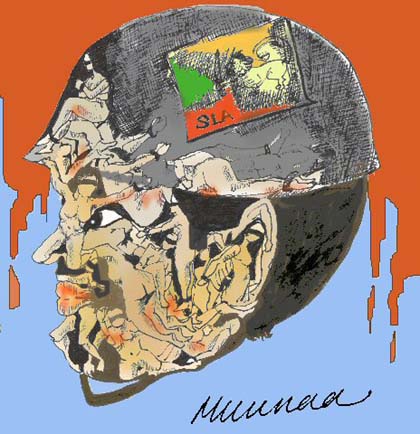
On the day Sri Lanka’s president attempts to visit the Tamil city of Jaffna, a familiar scene unfolds. Peaceful Tamil demonstrators are swarmed by armed Sri Lankan officers; the military erects roads blocks to cordon off demonstrators; and, the police resort to firing water cannons in an attempt to disperse the Tamil public.
None of this comes as a surprise to Eelam Tamils who for years have withstood the brunt of a brutal military occupation. Indeed, despite the tactics of intimidation and violence, Tamils did not shrink from their protests but fought back. In Nallur some chose to meet police violence with cow dung, whilst others responded to water cannons by bringing out shampoo. A show of continued defiance to military rule.
In retaliation to this, Sri Lanka’s police force conducted sweeping arrests of leading demonstrators, including civil society leader Velan Swamigal. The egregious crackdown sparked international criticism but little action thus far. It follows a sordid history of continuous attempts to monitor and stifle the legitimate demands of Eelam Tamils.
Ironically, the heavy handed military response to the protests came as Sri Lanka’s president has promised to resolve the decades long grievances of Tamils before the island’s Independence Day. Whilst some news outlets have highlighted the recently announced cuts to Sri Lanka’s military budget, it is important to bear in mind where these forces are concentrated - the Tamil homeland.
It is in the North and East where Sri Lanka’s military has paved over gravestones to build up its bases; it is here that the military pillaged Tamil land for farming and agriculture; it is in the Tamil heartland that Sinhala monuments have been erected to mark their dominance.
The pledge to strip down Sri Lanka’s bloated military amidst a devastating economic crisis comes as a economic necessity. However, the question is not only over size but scope and nature of the military. Serious questions must be asked as to why the gambit of the military includes running a chain of luxury hotels, regulating port authorities, and even overseeing the island’s disastrous response to the pandemic. Questions must also be asked as to why an almost exclusive Sinhala Buddhist military continues to rule large tracts of agriculture and regulate the fisheries in Tamil majority regions, often to the determinate of local Tamils. Why such a massive military force is so often engaged in the erection of Buddhist monuments and crackdowns on Tamil memorials.
The military's disproportionate size is a symptom of a corrosive underlying ideology of Sinhala Buddhist majoritarianism. A bedrock principle that the island’s president, Ranil Wickremesinghe has refused to stand against. Whilst Sri Lanka’s president has made a show of engaging in tokenistic debates with the Tamil Nationalist Alliance (TNA); these negotiations are beginning to disintegrate. The TNA have slammed the president for its failure to do the bare minimum to meet Tamil demands. A key demand of which is the immediate release of Tamil land the Sri Lankan military continues to occupy.
The consistent failure of Sri Lanka’s leaders to breakaway from of Sinhala Buddhist supremacy and of militarisation has led the island to repeated cycles of violence. Whilst the TNA has continued to urge the Sri Lankan government to meet its commitments to Tamils, much of the Tamil public have grown wary of a long history of broken promises. Instead, they have called on the international community to put pressure on the island’s leaders to bring about genuine reform. To demand the demilitarisation of the Tamil homeland and allow genuine self-governance for Eelam Tamils.
We need your support
Sri Lanka is one of the most dangerous places in the world to be a journalist. Tamil journalists are particularly at threat, with at least 41 media workers known to have been killed by the Sri Lankan state or its paramilitaries during and after the armed conflict.
Despite the risks, our team on the ground remain committed to providing detailed and accurate reporting of developments in the Tamil homeland, across the island and around the world, as well as providing expert analysis and insight from the Tamil point of view
We need your support in keeping our journalism going. Support our work today.
For more ways to donate visit https://donate.tamilguardian.com.

